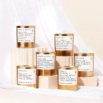Introduction
When it comes to selecting the perfect candle for your home, the type of wax can make a big difference in your overall experience. Each wax type; beeswax, soy wax, and paraffin wax—has unique characteristics that affect how the candle burns, smells, and impacts your living space. In this guide, we’ll break down the benefits of each, so you can choose the best candle for your needs.
1. Natural Origins and Production
Beeswax:
- Where It Comes From: Beeswax is made by bees and is a natural byproduct of honey production.
- Eco-Friendly: It’s sustainably harvested, supporting bee populations and the environment.
Soy Wax:
- Plant-Based: Made from soybean oil, soy wax is a renewable and natural option.
- Sustainable Choice: Soybeans are grown widely, making this a more eco-conscious choice compared to petroleum-based options.
Paraffin Wax:
- Petroleum-Based: Derived from crude oil, paraffin wax is a common but non-renewable option.
- Abundant: Easily found in many candles due to its affordability and availability.
2. Burn Quality and Aroma
Beeswax:
- Long-Lasting: Beeswax candles burn longer due to their high melting point.
- Natural Scent: They emit a subtle, natural honey fragrance, perfect for creating a cozy atmosphere without overpowering scents.
Soy Wax:
- Smooth and Clean: Soy wax burns evenly and has a good scent throw, making it ideal for scented candles.
- Versatile Scents: It can carry various fragrances well, giving you plenty of options to choose from.
Paraffin Wax:
- Strong Scent Throw: Known for its ability to hold and release fragrances, making it popular for strong-scented candles.
- Variety of Styles: Available in many shapes and sizes, from pillars to votives.
3. Health and Environmental Impact
Beeswax:
- Air-Purifying: Beeswax candles release negative ions that can help purify the air, reducing pollutants and allergens.
- Hypoallergenic: A great choice for those with allergies or sensitivities.
Soy Wax:
- Non-Toxic: Burns cleaner than paraffin, producing less soot and fewer chemicals.
- Good for Indoors: Safe for indoor use, with minimal impact on air quality.
Paraffin Wax:
- Potential Irritants: Can emit soot and chemicals like toluene and benzene, which may affect air quality.
- Allergy Considerations: May cause irritation for those with respiratory issues.
4. Cost and Accessibility
Beeswax:
- Premium Experience: Often priced higher due to its natural and artisanal qualities.
- Unique and Special: Ideal for those looking for a luxurious, natural candle experience.
Soy Wax:
- Affordable and Accessible: More budget-friendly than beeswax and widely available in various scents and styles.
- Great for Everyday Use: Perfect for regular use without breaking the bank.
Paraffin Wax:
- Economical Choice: The most affordable option, great for those who want a variety of candles at a lower price point.
- Widespread Availability: Easily found in stores and comes in numerous designs and scents.
Conclusion
Choosing the right candle wax depends on what you’re looking for in a candle. If you value natural, clean-burning candles with a subtle scent, beeswax is an excellent choice. Soy wax offers a clean burn with great scent variety, perfect for everyday use.
At Pittsburgh Soy Candle, we believe in the exceptional quality and benefits of soy candles. From their long burn time to their natural air-purifying properties, soy candles provide a unique and luxurious experience. We hope you’ll choose beeswax and discover the warmth, purity, and natural beauty they bring to your home. Enjoy the comforting glow of a beautiful soy candle, and experience the difference for yourself.
Share






